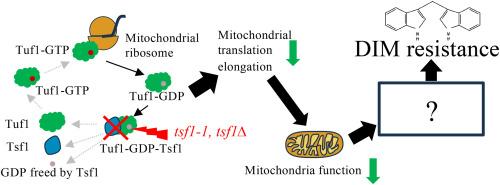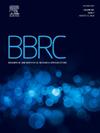线粒体翻译减少使小鼠具有 3,3'-Diindolylmethane 抗性
IF 2.5
3区 生物学
Q3 BIOCHEMISTRY & MOLECULAR BIOLOGY
Biochemical and biophysical research communications
Pub Date : 2024-10-23
DOI:10.1016/j.bbrc.2024.150864
引用次数: 0
摘要
3,3'-二吲哚甲烷(DIM)是从天然水果和蔬菜中提取的一种化合物,其抗癌活性已得到广泛认可。然而,其作用机制仍不明确。在这项研究中,为了研究 3,3'-Diindolylmethane 的分子机制,我们在线粒体翻译延伸因子 EF-Ts (tsf1+)(线粒体蛋白质翻译的一个关键因子)基因中发现了一种新的突变,这种突变能使小鼠酵母产生 DIM 抗性。tsf1Δ 也赋予了 DIM 抗性。研究发现,线粒体翻译的减少是导致小鼠酵母产生 DIM 抗性的原因,因为在使用氯霉素(一种特异的线粒体翻译抑制剂)处理后,细胞获得了 DIM 抗性。值得注意的是,tsf1Δ在缺乏自噬相关蛋白 Atg7 或核包膜蛋白 Lem2 的情况下也能产生 DIM 抗性。总之,这项研究揭示了 DIM 的新生物学功能,并强调了它作为抗癌剂的潜力。本文章由计算机程序翻译,如有差异,请以英文原文为准。

Decreased mitochondrial translation confers 3,3′-Diindolylmethane resistance to Schizosaccharomyces pombe
3,3′-Diindolylmethane (DIM), a compound derived from natural fruits and vegetables, is widely recognized for its anti-cancer activity. However, its action mechanisms remain ambiguous. In this study, to study the molecular mechanism of 3,3′-Diindolylmethane, we identified a novel mutation in the gene of mitochondrial translation elongation factor EF-Ts (tsf1+), a key factor in mitochondrial protein translation, that conferred DIM resistance to Schizosaccharomyces pombe. The tsf1Δ also conferred DIM resistance. Decreased mitochondrial translation was found to be responsible for conferring DIM resistance to Schizosaccharomyces pombe, as the cells gained DIM resistance after treatment with chloramphenicol, a specific mitochondrial translation inhibitor. Notably, tsf1Δ conferred DIM resistance in the absence of either autophagy-related protein, Atg7, or nuclear envelope protein, Lem2, two proteins that have been reported to be required for cell survival in the presence of DIM. Overall, this study revealed novel biological functions of DIM and highlighted its potential as an anti-cancer agent.
求助全文
通过发布文献求助,成功后即可免费获取论文全文。
去求助
来源期刊
CiteScore
6.10
自引率
0.00%
发文量
1400
审稿时长
14 days
期刊介绍:
Biochemical and Biophysical Research Communications is the premier international journal devoted to the very rapid dissemination of timely and significant experimental results in diverse fields of biological research. The development of the "Breakthroughs and Views" section brings the minireview format to the journal, and issues often contain collections of special interest manuscripts. BBRC is published weekly (52 issues/year).Research Areas now include: Biochemistry; biophysics; cell biology; developmental biology; immunology
; molecular biology; neurobiology; plant biology and proteomics

 求助内容:
求助内容: 应助结果提醒方式:
应助结果提醒方式:


